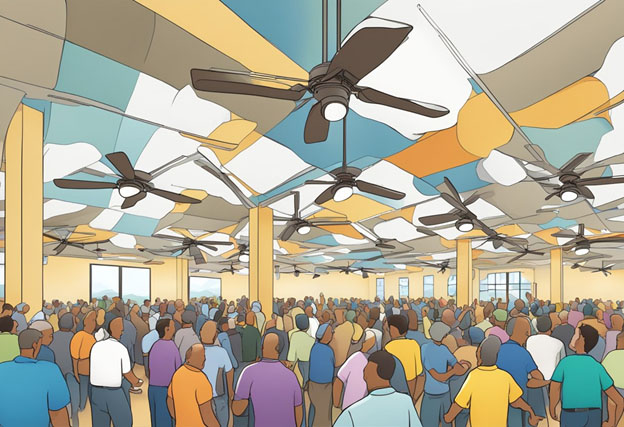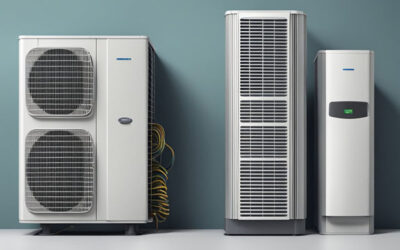Ceiling fans are a popular and energy-efficient way to cool down a room during the hot summer months. However, many people believe that running a ceiling fan in an empty room can help lower the temperature of the entire house. This is a common misconception, as ceiling fans are designed to cool people, not empty rooms.
Ceiling fans work by creating a wind chill effect, which helps to evaporate sweat from the skin and make people feel cooler. The breeze created by the fan can make a room feel up to 4 degrees cooler, but it does not actually lower the temperature. In fact, running a ceiling fan in an empty room can actually waste energy and increase your electricity bill. It’s important to remember that ceiling fans are meant to cool people, so it’s best to turn them off when you leave a room.
The Basics of Ceiling Fans
Ceiling fans have been a popular addition to homes and offices for many years, providing a cost-effective and energy-efficient way to cool people down. In this section, we will cover the history of ceiling fans, how they work, and the different types of ceiling fans available on the market.
History of Ceiling Fans
The first ceiling fans were invented in the 1860s and were powered by water. They were used primarily in commercial settings, such as factories and warehouses, to help keep workers cool. In the 1880s, the first electric ceiling fans were introduced, and they quickly became popular in homes and offices.
Over time, ceiling fans have evolved to become more energy-efficient and stylish. Today, they come in a variety of designs and colors to match any decor.
How Ceiling Fans Work
Ceiling fans work by creating a wind-chill effect, which cools the skin by increasing the rate of evaporation. As the fan blades rotate, they create a breeze that moves air around the room. This movement of air helps to evaporate sweat from the skin, which makes people feel cooler.
Ceiling fans are also useful in the winter months. By reversing the direction of the fan blades, they can help to circulate warm air around the room, reducing the need for heating.
Types of Ceiling Fans
There are many different types of ceiling fans available on the market, each with its own unique features and benefits. Some of the most common types of ceiling fans include:
- Standard Ceiling Fans: These are the most popular type of ceiling fan and come in a variety of sizes and styles.
- Energy-Efficient Ceiling Fans: These fans are designed to use less energy than standard ceiling fans, making them a great choice for those looking to save money on their energy bills.
- Outdoor Ceiling Fans: These fans are designed to withstand the elements and are perfect for use on patios, decks, and other outdoor areas.
- Remote-Controlled Ceiling Fans: These fans can be controlled using a remote, making them easy to operate from anywhere in the room.
Overall, ceiling fans are a great way to cool people down without wasting energy on empty rooms. With so many different types of ceiling fans available, there is sure to be one that meets your needs and fits your style.
Benefits of Using Ceiling Fans
Ceiling fans have been used for decades to provide comfort and relief during hot weather. They are an affordable and energy-efficient alternative to air conditioning units. In this section, we will explore the benefits of using ceiling fans.
Energy Efficiency and Cost Savings
Ceiling fans consume less energy than air conditioning units, making them a cost-effective option for homeowners. They use only a fraction of the electricity required by an air conditioning unit, which can lead to significant savings in energy bills. In addition, ceiling fans can be used in conjunction with air conditioning units to reduce the load on the air conditioning system, resulting in even greater energy savings.
Enhancing Air Circulation
Ceiling fans are designed to move air around a room, creating a gentle breeze that can help to cool people down. They work by creating a wind-chill effect, which can make a room feel up to 8 degrees cooler. In addition, ceiling fans can help to circulate air throughout a room, which can reduce the buildup of hot air and improve overall air quality.
Cooling Effect on People
Ceiling fans are an effective way to cool people down during hot weather. They create a gentle breeze that can help to evaporate sweat and provide relief from the heat. In addition, ceiling fans can be used in conjunction with air conditioning units to create a more comfortable environment. By using a ceiling fan, homeowners can reduce their reliance on air conditioning units, which can save money on energy bills and reduce their carbon footprint.
Overall, ceiling fans are a cost-effective and energy-efficient way to cool people down during hot weather. They provide a range of benefits, including energy savings, improved air circulation, and a cooling effect on people. By using a ceiling fan, homeowners can stay cool and comfortable while reducing their impact on the environment.
Installation and Placement
Choosing the Right Ceiling Fan
Before purchasing a ceiling fan, it is important to consider the size of the room and the height of the ceiling. A fan that is too small for the room will not provide adequate cooling, while a fan that is too large can be overpowering and noisy. The recommended fan size for a room can be determined by measuring the length and width of the room in feet and then using a chart to find the appropriate fan size.
Ceiling fans come in a variety of styles and finishes, so it is important to choose one that complements the décor of the room. It is also important to consider the blade pitch, which determines the amount of air the fan can move. A blade pitch of 12-15 degrees is recommended for optimal performance.
Installation Guidelines
Installing a ceiling fan requires some electrical knowledge and experience, so it is recommended to hire a professional electrician. However, for those who are confident in their abilities, the following guidelines should be followed:
- Turn off the power to the room at the circuit breaker.
- Remove the existing light fixture and electrical box.
- Install a new electrical box rated for ceiling fans.
- Assemble the ceiling fan according to the manufacturer’s instructions.
- Attach the mounting bracket to the ceiling box.
- Connect the wiring from the fan to the wiring in the ceiling box.
- Attach the fan blades and light kit, if applicable.
- Turn the power back on and test the fan.
Optimal Placement for Efficiency
Ceiling fans work best when they are installed in the center of the room and at least 7 feet above the floor. This allows for optimal air circulation and prevents the fan from being a hazard to people walking in the room. The blades of the fan should be at least 18 inches away from any walls or obstacles to allow for proper airflow.
In rooms with high ceilings, an extension rod can be used to lower the fan to a more comfortable height. In rooms with low ceilings, a flush mount kit can be used to install the fan without a downrod. It is important to follow the manufacturer’s instructions for proper installation and placement to ensure optimal performance and safety.
Usage Tips
Proper Operation for Maximum Comfort
Ceiling fans can help keep a room cool and comfortable, but it’s important to use them correctly. To get the most out of your ceiling fan, make sure it’s installed in the right location. The fan should be mounted at least 7 feet above the floor and 18 inches from the nearest wall. This will help ensure that the blades have enough clearance to move air effectively.
In addition, make sure the fan is rotating in the correct direction. During the summer months, the fan should rotate counterclockwise to create a cool breeze. During the winter months, the fan should rotate clockwise to push warm air down from the ceiling.
Seasonal Adjustments
Ceiling fans can be used year-round to help keep a room comfortable. During the summer months, turn the fan on high and let it run counterclockwise to create a cool breeze. During the winter months, turn the fan on low and let it run clockwise to push warm air down from the ceiling.
Maintenance and Cleaning
To keep your ceiling fan running smoothly, it’s important to perform regular maintenance and cleaning. Dust and dirt can accumulate on the blades and motor, which can affect the fan’s performance. To clean the fan, turn it off and wait for the blades to stop moving. Then, use a soft cloth or brush to gently wipe the blades and motor housing. Avoid using water or harsh chemicals, as these can damage the fan.
In addition, make sure to check the fan’s screws and bolts regularly to ensure they’re tight. Loose screws and bolts can cause the fan to wobble or make noise, which can be annoying and potentially dangerous. If you notice any issues with your ceiling fan, such as wobbling or unusual noises, turn it off and contact a qualified electrician for assistance.
Innovations in Ceiling Fan Technology
Smart Ceiling Fans
Ceiling fans have come a long way since their inception, and one of the latest innovations in ceiling fan technology is the introduction of smart ceiling fans. These fans can be controlled remotely through a smartphone app or voice commands. Some of the features of smart ceiling fans include the ability to adjust the speed and direction of the blades, turn the fan on and off, and even change the color of the light. They can also be integrated with other smart home devices, such as thermostats, to provide a more comfortable environment.
Energy-Saving Features
Ceiling fans are already known for their energy-saving capabilities, but manufacturers are constantly finding ways to improve their efficiency. One of the latest energy-saving features is the use of DC motors, which are up to 70% more efficient than traditional AC motors. Some ceiling fans also come with built-in sensors that can detect when someone enters or leaves the room, and automatically adjust the fan speed accordingly. This not only saves energy but also helps to prolong the life of the fan.
Design Trends
Ceiling fans are no longer just functional but have also become a design statement. Manufacturers are now offering a wide range of styles, colors, and finishes to suit any decor. Some of the latest design trends include sleek and modern fans with minimalist blades, vintage-inspired fans with intricate detailing, and even fans with built-in LED lights. Additionally, manufacturers are now offering customizable options such as interchangeable blades and light fixtures, allowing customers to create a fan that truly reflects their personal style.
Overall, the innovations in ceiling fan technology have made them more efficient, convenient, and stylish than ever before. With the ability to control them remotely, save energy, and customize their design, ceiling fans are becoming an increasingly popular choice for cooling people, not empty rooms.
Environmental Impact
Reduction in Carbon Footprint
Ceiling fans have a significant impact on reducing carbon footprint. They consume much less energy compared to air conditioning units. According to the U.S. Department of Energy, ceiling fans use only around 10% of the energy that air conditioners use, resulting in a significant reduction in carbon emissions.
Ceiling fans also help to reduce the overall energy consumption of a household. By circulating the air, they create a cooling effect, allowing people to set their air conditioning units to higher temperatures. This reduces the amount of energy required to cool a room, resulting in a lower carbon footprint and reduced energy bills.
Contribution to Sustainable Living
Ceiling fans are an important part of sustainable living. They are energy-efficient and help to reduce the overall carbon footprint of a household. They also contribute to a more comfortable living environment, without the need for excessive energy consumption.
When choosing a ceiling fan, it is important to consider its energy efficiency. Look for fans that have the ENERGY STAR® label, which indicates that they meet strict energy efficiency guidelines set by the U.S. Environmental Protection Agency.
In summary, ceiling fans are an eco-friendly and cost-effective way to cool a room. They help to reduce carbon emissions and contribute to sustainable living. By choosing an energy-efficient ceiling fan, homeowners can reduce their energy bills and make a positive impact on the environment.





0 Comments